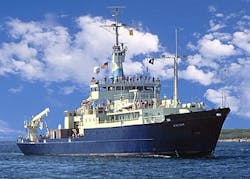Navy uses UAV data to improve performance and stealth qualities of communications and radar
ARLINGTON, Va., 5 Aug. 2013. U.S. Navy researchers are using small ship-launched unmanned aerial vehicles (UAVs) to gather ocean and atmospheric data necessary to improve the performance and stealth qualities of maritime communications, radar, and other crucial RF and microwave technologies.
The experiments, conducted off Virginia Beach, Va., last month used Boeing Insitu ScanEagle small long-endurance UAVs flying off the Navy-owned research vessel RV Knorr to explore ocean and atmospheric weather variations that can change the angle that radar and radio waves bend, making it more difficult for ships to remain undetected and hindering their ability to communicate or locate adversaries, Navy officials say.
Conducting the experiments were environmental experts from the Office of Naval Research (ONR) in Arlington, Va.. who are trying to find ways to boost the Navy’s radar and communications performance at sea.
Researchers used ScanEagle UAVs and unmanned undersea and surface vehicles to make real-time measurements of variations in atmospheric and ocean conditions. Fluxes and turbulence from the interaction of air and sea can alter the path of electromagnetic waves in radar and communications systems, researchers explain.
Atmospheric ducts can trap energy in the lowest layer of the atmosphere and enable radar and communications to travel over much longer distances that expected, increasing the chances that information could reach adversaries, officials say.
Energy also could be trapped aloft and cause unpredictable performance of radar, communications, and other RF systems. These conditions, for example, could prevent Navy radars from seeing things even if they normally would be well within range.
“We need to understand where we are in relation to this ducting environment and understand the energy we’re emitting and the energy an adversary is emitting,” says Dan Eleuterio, program officer for ONR’s Ocean Battlespace Sensing Department. “If we don’t know these things, it’s like rolling the dice. If we do know them, it can give us a tactical advantage.”
Small UAVs like the ScanEagle can launch from a ship, get close to the ocean’s surface, and fly for extended periods of time, researchers point out. During the experiment, the UAVs flew as close as 100 feet above the ocean's surface to take precise measurements.
The Knorr research vessel belongs to the Navy and is operated by the Woods Hole Oceanographic Institution in Woods Hole, Mass. The vessel is best known as the ship that supported researchers in 1985 who discovered the wreck of the sunken ocean liner Titanic.
Developed by the Marine Physical Laboratory at Scripps Institution of Oceanography, the sensor packages used on the ScanEagle UAVs measured everything from surface waves, winds, humidity and temperature, to fluxes in mass, momentum and energy. Once collected, the data was delivered to personnel aboard a nearby destroyer and amphibious assault ship participating in the experiment.
“In the old days, we launched weather balloons to give us the best data on the real environment, but that only happened in one place and at one time of day,” says Cmdr. Rob Witzleb, head of capabilities and requirements on the staff of the Oceanographer of the Navy.
“Many miles and hours later, we were often left looking for answers when weapon systems didn’t perform the way we thought they would," Witzleb says. "Using UAVs is giant leap forward in that they can give us near- continuous data, across multiple parameters where the atmosphere is the most unpredictable.”
For more information contact the Office of Naval Research online at www.onr.navy.mil.
